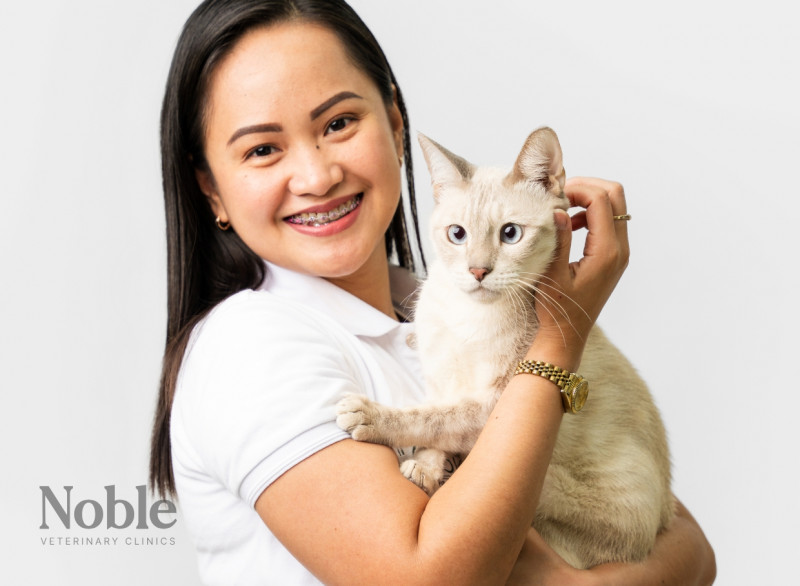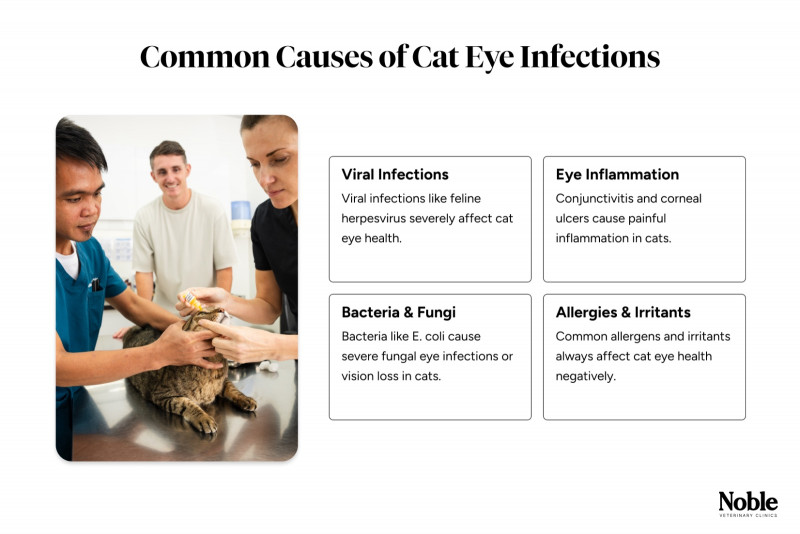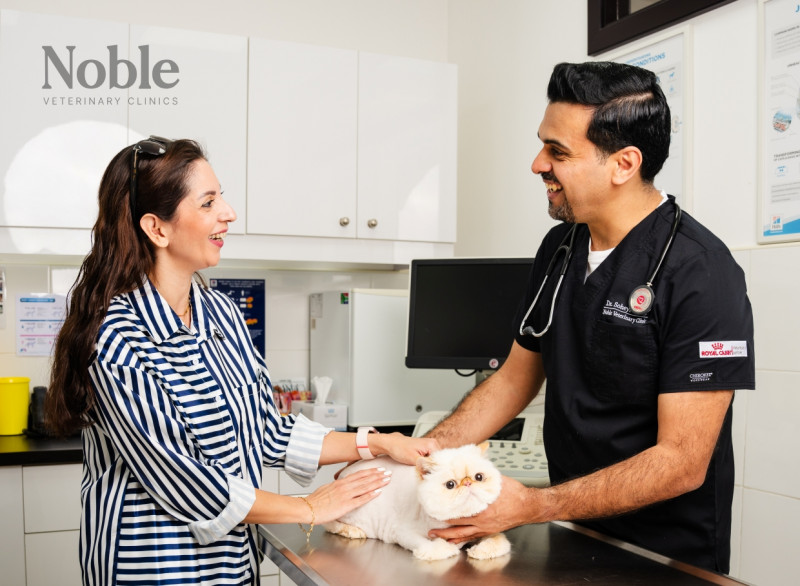
This is a sponsored guest post.
Cats have very good eyesight as they rely on their vision to get through their environment safely, hunt small prey, and communicate. Their eyes can detect movement even in low light, which is why cats are naturally nocturnal creatures.
When cats get eye infections, they become uncomfortable and susceptible to long-term eye damage when not treated immediately.
Many cat eye infections can be mild and can resolve on their own. But there’s the risk of complications that require veterinary attention. Understanding the causes, symptoms, and treatment options for cat eye infections is a must for any pet owner.

How Do Cats Get Eye Infections?
Cats can develop eye infections for various reasons. Most often, cats that have weak immune systems are more prone to developing these infections.
Feline Upper Respiratory Infections
Feline upper respiratory infections, or URIs, are caused by viruses like the feline calicivirus and herpesvirus. These viral infections can lead to inflammation in the cat’s eyes and other severe health conditions.
In regions like Dubai, cats that are checked into cat hotels and daycares are often at risk due to the number of cats they socialize with. Unneutered cats are also susceptible to getting URIs since they may roam and get in contact with infected stray cats.
Conjunctivitis and Corneal Issues
Conjunctivitis occurs when the tissue covering a cat’s eye becomes inflamed. This is a common eye infection in cats. It may cause redness, discharge, and swelling.
Other eye problems that affect cats are corneal ulcers and other issues. These may happen when a cat has eye infections or injuries. If these are left untreated, the cat might completely lose its vision.
Bacterial and Fungal Infections
Bacterial infections are caused by poor hygiene, wounds, or exposure to contaminants. Fungal infections, on the other hand, are caused by fungi in the environment. Infections from fungi are rare in cats, but a feline that has a weak immune system can acquire this illness.
Allergies and Irritants
Some cat eye infections are caused by allergic reactions to irritants, such as pollen, smoke, dust, certain foods, or medications. Some irritants can also be chemicals in household products.
In dense cities like Dubai or New York, the air can be full of irritants that might cause eye infections in cats.
What Are the Signs of Eye Infection in Cats?
As a cat owner, you must know the initial symptoms of eye infections in your pet. With this knowledge, you can help your cat get immediate veterinary care for treatments and rapid recovery.
Symptoms of Cat Eye Infections
You’ll easily notice if your cat has an eye infection. The common symptoms include:
- Redness and swelling
- Watery eyes or excessive tearing
- Frequent blinking or squinting
- Constant rubbing at the eyes
- Sensitivity to bright lights
When your cat is showing any of these symptoms, you must schedule a health check-up with your veterinarian as soon as possible. Vet clinics are equipped with advanced diagnostic tools to help diagnose infections accurately so veterinarians know the right treatments to use.
If you leave these symptoms behind, your cat may experience long-term eye damage that may even lead to blindness.
How Are Cat Eye Infections Diagnosed?
Detecting cat eye infections involves a series of diagnostic methods done by professional vets. Dubai veterinarians often use various diagnostic techniques to determine the cause of eye infections in cats.
The combination of these methods can help vets diagnose the cause of infection accurately and enable them to provide effective treatments for your cat’s infection.
Physical Exams
The vet will first conduct a physical examination on a cat. The cat’s eyes will be inspected closely for any clinical signs of redness, inflammation, swelling, discharge, or injuries.
Your veterinarian will also check whether both of your cat’s eyes are affected and if it is showing any symptoms of discomfort. Knowing these initial signs will give the vet an idea of the infection’s cause.
Diagnostic Tests
After the vet does the physical exam, some diagnostic tests might be needed to accurately determine the cause of the cat eye infection.
Usually, the vet will take swabs or discharge samples from your cat’s eye. These samples will help determine if the infection is fungal, viral, or bacterial. Identifying the pathogen will help the vet prescribe the right medications or do procedures that will effectively treat your cat.
Fluorescein Staining
Fluorescein staining involves using a special dye on the eye. Then, the vet will use a blue light tool to find any cornea damage or injuries on the eye. The dye will glow if there’s any positive sign of damage.

How to Treat and Recover From Cat Eye Infections
Depending on the cause of the eye infection, the vet may proceed with different treatment options. These may include medications or surgery.
Veterinarians may prescribe antibiotic topicals for bacterial infections, antivirals for viral infections, or anti-inflammatory medications for pain and swelling. For severe cat eye infections, the vet may also prescribe oral antibiotics.
For severe cases, such are corneal damage or injuries and abscess formation, your veterinarian may need to perform surgery on your cat. Surgeries may also be needed for recurrent infections or those that don’t get better through other treatment options.
No matter the treatment method, whether medications or surgeries, your vet will advise a follow-up clinic visit after a couple of days. Through this, your vet will monitor the status of your cat’s recovery.
During recovery, you should prepare a clean and sanitized area where your cat can get better. You may need to get your pet an e-collar to help prevent it from scratching or rubbing its eyes.
How to Prevent Eye Infections in Cats
Preventing eye infections in your cat is not an impossible feat. First, make sure to schedule regular health consultations for your cat. Regular vet visits will make sure that your cat’s eyes are constantly monitored and checked for early symptoms of infection.
Next, keep your cat’s living space clean and sanitized to keep bacteria, fungi, and viruses from infecting your pet’s eyes.
Lastly, groom your cat regularly. Irritants, bacteria, and other causes of eye infection can attach to your cat’s fur and paws. Grooming your cat regularly prevents the buildup of these allergens and causes of infection.
Conclusion
Cat eye infections are manageable and treatable as long as they are detected early and are given effective veterinary care.
As a cat owner, you must recognize early signs of these infections in your pet so you can help reduce the risk of complications such as blindness.
With regular vet visits and keeping your cat’s living environment clean, you can help maintain your cat’s eyes healthy and infection-free.
FAQs
Is cat eye infection contagious to humans?
There are certain bacterial and viral cat eye infections that can be transmitted to humans. This might be rare, but it’s important to practice good hygiene when caring for your cat, especially when it has an eye infection.
How can I treat my cat’s eye infection at home?
You can treat your cat’s eye infection at home by consulting a veterinarian first. Vets usually prescribe eye drops or other medications for mild eye infection cases, which you can administer at home. Make sure that you understand the vet’s instructions on how to give these medications to your cat.
Can a cat eye infection heal on its own?
Some mild cat eye infections can resolve on their own. However, most cases require veterinary intervention to prevent complications.
When should I worry about my cat’s eye infection?
You should begin to worry about your cat’s eye infection if it isn’t healing on its own after a few days. If symptoms worsen, such as excessive swelling, pus eye discharge, or excessive squinting, you should take your cat to the emergency vet immediately.
Can I use human eye drops on my cat?
No, you shouldn’t use human eye drops on your cat unless your vet specifically directs you to do so. Cats and humans have different physiologies, so human medications might cause more harm to your cat.

Hi there! I am Emily Evert, the owner of Emily Reviews. I am 28 and live in a small town in Michigan with my boyfriend Ryan and our two pugs. I have a large family and I adore my nieces and nephews. I love reading memoirs, and learning about child development and psychology. I love watching The Game of Thrones, Teen Mom, Sister Wives and Veep. I like listening to Jason Isbell, John Prine, and other alt-country or Americana music. I created Emily Reviews as a creative outlet to share my life and the products that I love with others.
This post currently has one response.






Thanks for the info.